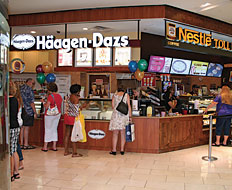Having opened his first Nestlé Toll House unit in 2007, Howard Taylor quickly became acquainted with the quick-serve industry and today owns and operates five units in Michigan. Taylor caught wind of the partnership between Nestlé Toll House and Häagen-Dazs in February, and explored the option of cobranding his own locations.
In July, Taylor opened his first cobranded Nestlé Toll House/Häagen-Dazs unit, and he is already planning to do the same with the rest of his existing locations.
Taylor offers his advice to franchisees who are considering cobranding an existing unit, including how to keep your books, how to pick which brand to partner with, and how to leverage the relationship you have with your franchisor.
1. Make Sure It Fits
Each franchisee has a different idea of how a business should run. With that, every franchisee has a different aspect of business they like to focus on for their units. Cobranding is quite a large business venture and should fit the model of your current business. It needs to match your interests in regards to how you want to grow.
There are plenty of options out there for expansion, and most of them require a lot of time and money. Cobranding is no different and needs to relate to your current model. Make sure both brands are going to be right for your business.
For my units, the two brands complement one another, giving our customer the same idea, just more options. Diversity in product is something customers like in today’s market.
With cobranding, consumers have more choices coming into your location, furthering and expanding your customer base. With different concepts comes different strengths in the overall aspect of running your business, and cobranding allows the franchisee to do that easily, while continuing to expand.
2. Rely on Existing Relationships
The economy will continue to be a contributing factor on how, or how not, to run your business. At the beginning phases of the cobranding projects, a lot of your success will come from the relationships you already have.
First, you need people in your corner to take you through the process. Try to find fellow franchisors with the cobranded storefront. One thing I did at the onset of the project was contact a lot of past franchisees and figure out what the state of their relationship was with the franchisor, who is your most important ally.
So far, the franchisor has been first-rate during this process. They have provided the necessary resources at the corporate level to help during the initial phases of the project.
It seems obvious, but the relationship you have with the franchisor is the second and most important relationship you need to keep developing. Better relationships will translate into better business.
3. Run It as Two Businesses
As a franchisee, you’re always making an investment in yourself. This is why you need to be sure to use all the tools the franchisor has put out there for you; they’re only designed to make you better.
Furthermore, go into the project having prepared to spend a lot of money, or you’ll be spending a lot of your time otherwise. There are saving opportunities during the initial phases. For instance, try to find a space that houses a similar concept rather than doing an entire build-out.
After you’ve cobranded your unit, it’s a good idea to keep track of the two units as separate bodies. I’ve kept my accounting style to run almost as two different businesses under the same roof. This way, I’m able to keep track of revenue, costs, and potential losses for both brands.
Cobranding will normally provide you the best return on investment that the quick-serve market has to offer. This is usually attributed to having a broader customer base for your product.
For my units, both brands specialize in desserts and both brands complement one another. This gives the customers more opportunity to purchase more products from the unit, hopefully at the same time.
Be sure to specialize in options that relate to the central idea of your original product. Other possibilities could work, but one that relates to your core concept will certainly be the easiest.
4. Be Strategic
Cobranding will allow a franchisee to make even more business decisions about their units and overall business. Speaking from my own experience as an example, I was not told what brand I had to use by the franchisor. This allowed me more opportunity to find the right brand that would go with my current product.
It did help that [Häagen-Dazs] was already an established brand. And our Nestlé Toll House location was established as well, so we already had some equipment in place that had multiple uses. It was a sound investment for us, especially because we already had one half established. We’ve seen our ice cream sales double versus the ice cream that we served before. I can only attribute that to branding awareness of Häagen-Dazs.
Again, I wanted to make sure both brands would balance each other. Nestlé Toll House and Häagen-Dazs are becoming more familiar with one another and create even more synergy when combined. It was a great experience for me to decide more or less the biggest part about cobranding: which brand to choose.
Most likely, there will be more than one choice for a cobranded unit. I even had the option to go with a deli concept. While other alternatives might work, you’ll have the easiest time with brands under the same corporate umbrella.
This translates into easier communication between you and the franchisor. It will also provide better resources, staffing options, and easier financial tracking to manage the cobranded unit.










